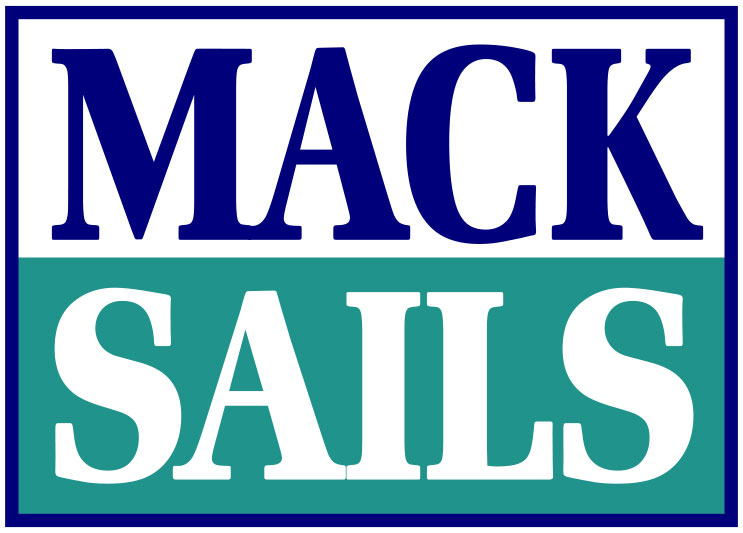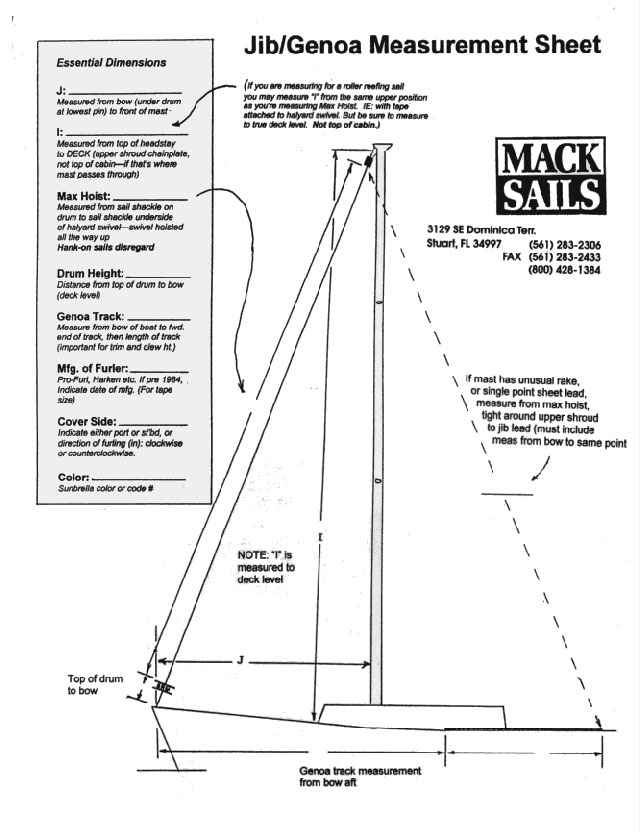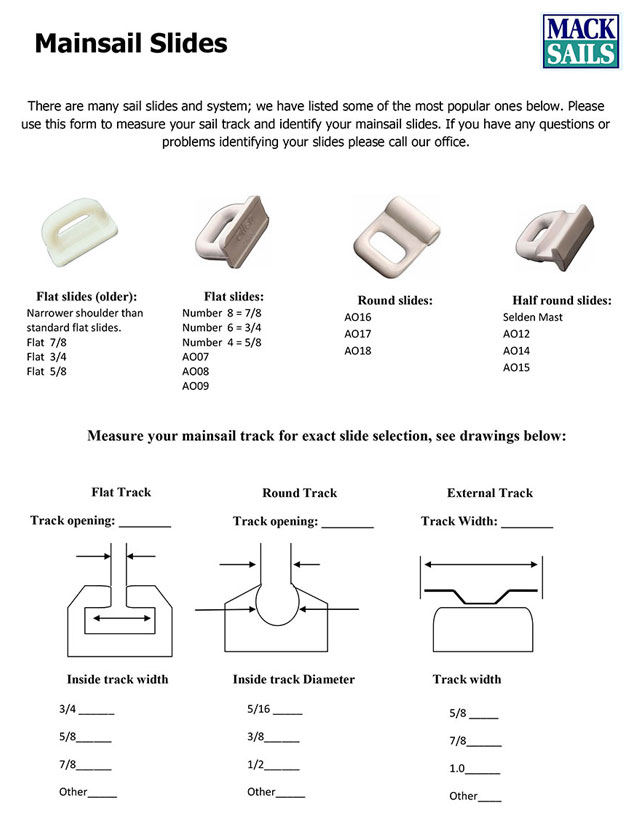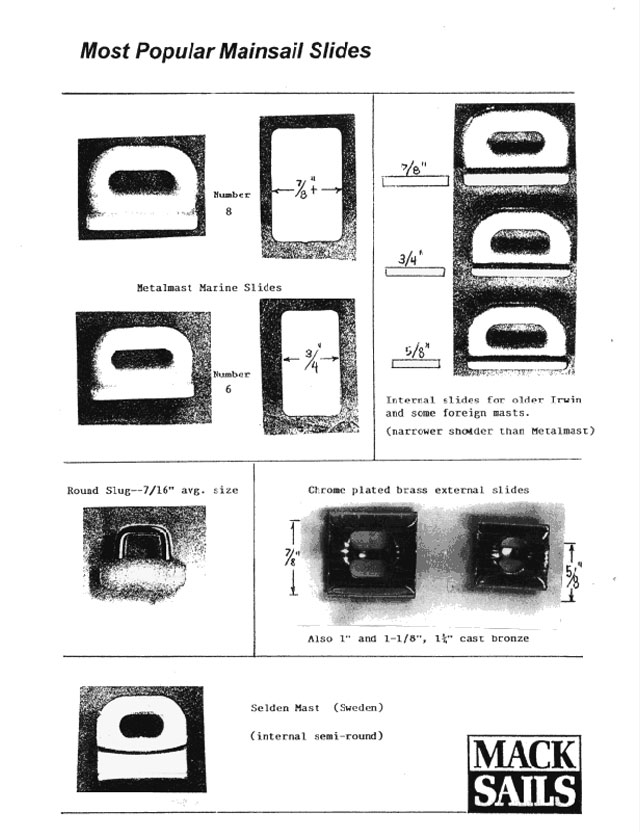Extraordinary Sailmakers
Sails
Mack Sails Advantage
See why Mack Sails has become the biggest, small sail loft in the USA
About our Sails
The Miter-Cut Genoa
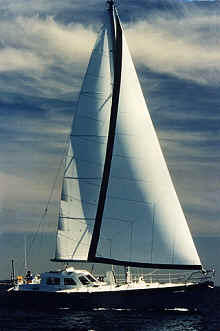 Fifty years ago virtually every genoa made for performance sailing was miter cut, like the photo the left, whether constructed of cotton, nylon or the then new Dacron. The miter in these sails was not simply a benign seam to hold the two halves of the sail together, but rather, a very sophisticatedly crafted avenue into the heart of the sail, that when done right, could anticipate the natural stretching and locking of the fibers in the cloth, guaranteeing that the draft would stay forward and the after area of the sail would stay flat and clean. Sailmaker’s reputations were built on the execution of their miters, perhaps none more so than Hood sails of the 1960’s (Many hard-used Hood genoas can be found today that look and perform better than their two or three year old counterparts from “modern lofts”). But, by the 70’s mitered genoas were being pushed into obscurity by the pressure of modern economics (the miter is labor intensive) and production requirements (it takes trained sailmakers, not kids hired off the street). Sailmakers were also eager to produce sails that were “fast out of the bag”. In reality, such sails were a little less fast each and every time used. The fact remains that material does stretch, no matter whether it’s new modern Kevlar, Spectra, Technora, Mylar and certainly Dacron-only cloth, and it’s the responsibility of the sailmaker to deal with the problem. In exotic materials, the solution is to radiate the panels out from each of the load corners of the sail. This is simple with CAD-CAM, and competitive because laminates are much more stable than woven-only cloth. But, woven-only Dacron is the odds-on favorite for cruising sails – lower cost and the incredible durability of 15-20 years in many sails. So, if the material is so durable, why not execute the design and construction to hold the shape in place as well? Bravo, the miter cut – especially for roller reefing genoas – which is practically every genoa built today. Other sailmakers simply make cross-cut genoas and shrug their shoulders about the consequences. We take the extra time and skill necessary to build a truly long-lasting, stay-flat when reefed, genoa – for serious cruising performance. Some sailmakers offer radial cut genoas from woven-only cloth, but we do not because the breakdown is rapid and the resulting washboard looking sail is something we would not want our name on.
Fifty years ago virtually every genoa made for performance sailing was miter cut, like the photo the left, whether constructed of cotton, nylon or the then new Dacron. The miter in these sails was not simply a benign seam to hold the two halves of the sail together, but rather, a very sophisticatedly crafted avenue into the heart of the sail, that when done right, could anticipate the natural stretching and locking of the fibers in the cloth, guaranteeing that the draft would stay forward and the after area of the sail would stay flat and clean. Sailmaker’s reputations were built on the execution of their miters, perhaps none more so than Hood sails of the 1960’s (Many hard-used Hood genoas can be found today that look and perform better than their two or three year old counterparts from “modern lofts”). But, by the 70’s mitered genoas were being pushed into obscurity by the pressure of modern economics (the miter is labor intensive) and production requirements (it takes trained sailmakers, not kids hired off the street). Sailmakers were also eager to produce sails that were “fast out of the bag”. In reality, such sails were a little less fast each and every time used. The fact remains that material does stretch, no matter whether it’s new modern Kevlar, Spectra, Technora, Mylar and certainly Dacron-only cloth, and it’s the responsibility of the sailmaker to deal with the problem. In exotic materials, the solution is to radiate the panels out from each of the load corners of the sail. This is simple with CAD-CAM, and competitive because laminates are much more stable than woven-only cloth. But, woven-only Dacron is the odds-on favorite for cruising sails – lower cost and the incredible durability of 15-20 years in many sails. So, if the material is so durable, why not execute the design and construction to hold the shape in place as well? Bravo, the miter cut – especially for roller reefing genoas – which is practically every genoa built today. Other sailmakers simply make cross-cut genoas and shrug their shoulders about the consequences. We take the extra time and skill necessary to build a truly long-lasting, stay-flat when reefed, genoa – for serious cruising performance. Some sailmakers offer radial cut genoas from woven-only cloth, but we do not because the breakdown is rapid and the resulting washboard looking sail is something we would not want our name on.
Mainsails
 Full Batten Mainsails account for 80% of the mainsails we build today. Full battens permit maximized area (roach) and the battens do for mainsails what the miter does for genoas – maintain the shape. Many racers prefer just the top two battens full, the lower two nearer to normal – for slightly more control over the shape of the bottom of the sail. For most sailors and cruisers all full battens make a faster, longer lasting and easier to set sail (our own boats, and America’s Cup boats as well, are rigged with all full battens). All our full batten mainsails include Battslide, Rutgerson, or other devices to tension and transition the load (batten to mast) as standard equipment. We also make available the inclusion of Strong or Harken mast track systems at a package price. All mainsails come standard with shelf foot, tell tails, etc. See the Special Features and Standards section.
Full Batten Mainsails account for 80% of the mainsails we build today. Full battens permit maximized area (roach) and the battens do for mainsails what the miter does for genoas – maintain the shape. Many racers prefer just the top two battens full, the lower two nearer to normal – for slightly more control over the shape of the bottom of the sail. For most sailors and cruisers all full battens make a faster, longer lasting and easier to set sail (our own boats, and America’s Cup boats as well, are rigged with all full battens). All our full batten mainsails include Battslide, Rutgerson, or other devices to tension and transition the load (batten to mast) as standard equipment. We also make available the inclusion of Strong or Harken mast track systems at a package price. All mainsails come standard with shelf foot, tell tails, etc. See the Special Features and Standards section.
Spinnakers / Cruising / Asymmetrical
Asymmetrical Cruising Spinnakers have been discovered by, and refined for, the racing fraternity and have come a long way since the early versions we started producing in the 1970’s. We developed and marketed the first cruising chute and sock combination for truly short handed use. We still use the same concept for short handed sailing but now it’s coupled with our new TRUE asymmetrical spinnaker. This sail can only be produced using sophisticated computer programs as each of the more than 30 panels is distinctly different in shape and length. This sail is a far cry from the cruising chutes sold by most sailmakers, usually a spherical head with a fairly flat lower section, which is really symmetrical except for one corner (the clew) lifted higher. The popular code zero’s are the genesis of the easements and are popularly fitted to a furler. This is most of what we see today.
Our Fast Radial Sails
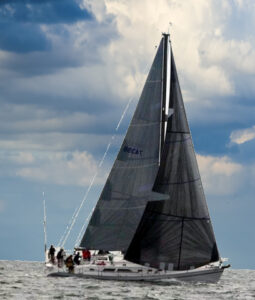 Most of Our Radial sails for cruising and club racing are constructed of “cloth” using one to two mils of Mylar/Dacron sandwich or woven warp-oriented Dacron/Pentex and Dacron/Kevlar. With few exceptions, this is the most expensive sail material to use, but delivers the highest performance potential. It is also 50 to 100% more expensive than woven Dacron and contributes to the higher price of these sails. Such sails lack the long-term durability of woven standard Dacron and are for sailors who don’t mind replacing them more often.
Most of Our Radial sails for cruising and club racing are constructed of “cloth” using one to two mils of Mylar/Dacron sandwich or woven warp-oriented Dacron/Pentex and Dacron/Kevlar. With few exceptions, this is the most expensive sail material to use, but delivers the highest performance potential. It is also 50 to 100% more expensive than woven Dacron and contributes to the higher price of these sails. Such sails lack the long-term durability of woven standard Dacron and are for sailors who don’t mind replacing them more often.
Special Features & Standards
Multi-stitched and more
All sails 6 oz. and up are multi-stitched on the seams with heavy (usually V138) dark blue thread. Dark blue V92 is used for our small boat sails, generally double stitched standard zig-zag. All spinnakers are multi-stitched.
two-plied
Leech tablings on all cruising sails are two-plied with an extra thickness of wider Dacron tape under the tabling and leech line. It is then triple stitched. This is valuable insurance against leech fatigue and will give your sail extra years of service.
Heavy duty leech lines are standard
Heavy duty leech lines are standard with all sails except storm sails and some spinnakers. Leech lines are always centered in the tabling with stitching on either side to prevent the very aft edge of the sail from “cracking,” a frequent problem with other sailmakers sails. Genuine ClamCleats are used to hold leech line adjustments at all reef and clews.
batten pockets consist of four thicknesses
All batten pockets consist of four thicknesses plus the extra “slab” to which it is sewn with double stitching. There is an internal wrap of heavy elastic or webbing in the pocket end. Most full batten pockets are made up of 12 oz. Dacron for extra chafe protection against the shrouds. All full batten sails are fitted with hardware at the forward end to tension the batten and provide a universal joint with the mast slide.
bolt ropes are New England Spun Dacron
All bolt ropes are New England Spun Dacron which is the finest for the purpose. Since these lines are hidden in the sail, inferior rope is often used by other sailmakers. When bolt ropes shrink (an inevitable feature of poor synthetics) the sail is rendered prematurely shapeless. The higher the quality of material, the longer lasting and performing is the sail, always our goal. As stated in all our literature, we use only the top of the line fabrics in all our sails. Few other sailmakers can make that claim.
corner rings and reef cringles
All corner rings and reef cringles are hydraulically pressed in stainless steel assemblies. All cruising mainsail headboards are heavy aluminum anodized installed with 3/16″ aircraft rivets. The shackle hole is lined with stainless steel and the adjacent bolt rope is leather bound. We seldom back up our corner and reefing rings with external webbing, preferring to use extra thicknesses of re-enforcing patch material in the corners, so that after-thought measures are unnecessary. Makes a nicer looking sail, too, which is one of our hallmarks.
hand sewn on with heavy webbing
Mainsail slides are all hand sewn on with heavy webbing for long life and kindness to the sail. Sails are all provided with tell tails and a Dacron bag. The dark stitching on our seams makes draft stripes not a necessity, but we will install them as an extra. Class insignia and numbers are also extras. Mainsail shelf foot is standard with our mainsails and there is no extra charge for Cunningham or jackline, if requested.
Sail Cloth
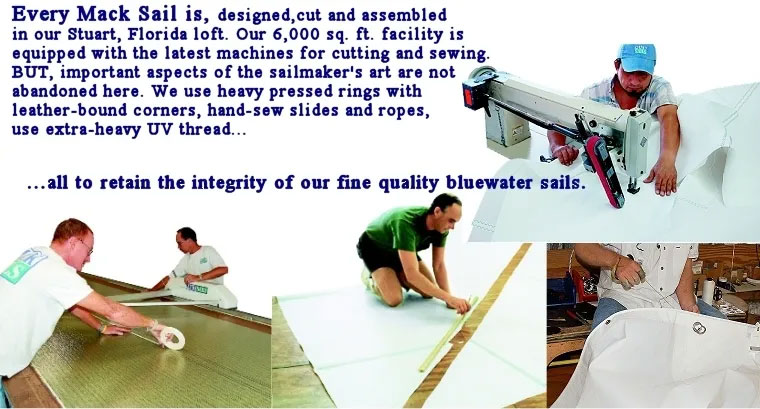
Discussion About Sailcloth
Years ago there were limited sailcloth options for sailmakers using Dacron for cruising and racing sails. That was then. The “this is now,” like most things, is a lot more complicated. We’ll put aside hi-tech racing sail material for now and talk about cruising sails – serious offshore, club knock-about racing, inshore, mom-and-pop – the sails that make up 75% of what we do. Unfortunately for the new sail buyer, sailcloth manufacturers have seen fit, for reasons of competitive pricing and the need to compete with offshore sources for OEM sails, to offer several grades of polyester fabric for sailmaking. Additionally unfortunate is that most of the brand name lofts, and the little guys too, use the not-so-good stuff for their “cruising” market and it’s difficult for the layman to tell the difference. The reason they do it is that the OEM cloths are so much cheaper. It’s very compelling.
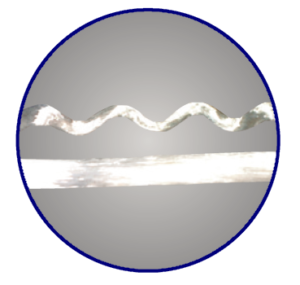
four quality levels of woven “crosscut” sailcloth available
Generally. there are four quality levels of woven “crosscut” sailcloth available to the sailmaker, including those custom woven for the really big lofts. The most popular producer of woven Dacron sailcloth, Bob Bainbridge’s Challenge Sailcloth, offers four “brands” of sailcloth that is used by most sailmakers, big and small. Their price reflects their quality. For example, the popular cruising weight cloth, 8 oz. plus, in the lowest quality, Performance Cruise, is $9.78 per yard. The next level up is their High Modulus which is $10.50 per yard. This High Modulus style is the most popular for practically every sailmaker’s cruising sails, except Mack Sails.
Premium brands - High Aspect & Marblehead
Challenge’s premium brands are called High Aspect and Marblehead. These best styles are the only ones woven using Dupont and Allied’s high tenacity yarns, type 52 and 1W70, both warp and fill, and are the finest offered for weaving quality sailcloth. The quality is reflected in the price. High Aspect is $14.15 per yard, and Marblehead is $15.01. This is the price sailmakers pay. The yarns for these best cloths are very tightly woven on specialized looms with emphasis on high crimp (slow, strong looms that super pack the heavier fill yarns against the warps yarns in the weaving process). High Aspect Dacron has heavier fill yarns that locate in the load direction of most mainsails and skinny jibs. Marblehead style is more balanced (fill and warp yarns of a more even denier) and is the absolute best for properly designed Dacron headsails and is particularly well suited to Mack Sails’ miter-cut roller reefing genoa. These fabrics are the finest most tightly woven fabrics in the world and rely on the quality of yarn and weave, rather than impregnated resins, to maintain integrity. Also, a big feature of these quality yarns chosen for the best cloth is their ability to shrink in the finishing process. This further tightens the cloth, locking the yarns together for better shape holding over time. The cheaper, more resinated loosely woven cloth breaks down rapidly allowing sails to become overly full with their draft migrating aft quickly. This is why we only stock and only use High Aspect Dacron and Marblehead Dacron for every one of our sails. Unfortunately, many sailmakers “bait and switch” as it’s difficult for the average sailor to tell the difference. We keep samples of all the styles and are happy to point out the subtle signs of difference between the common and the excellent.
Measurements
Mainsail
How to Video
Jib/Genoa
How to Video
Mack Pack
How to Video
Mainsail and Jib/Genoa Measurements
How to measure mainsail & Jib/Genoa sail
Sail Track & Mainsail Slides
How to measure sail track & identify mainsail slides
